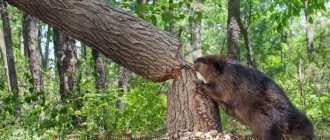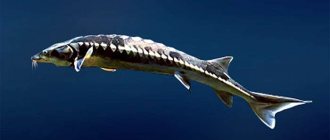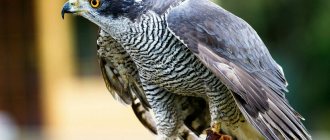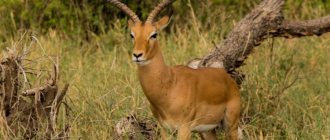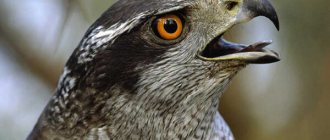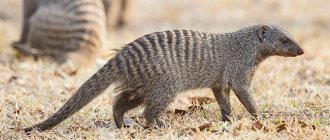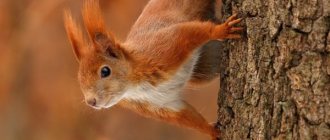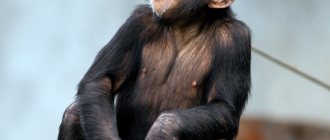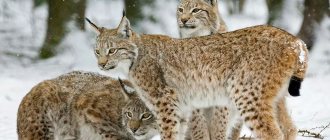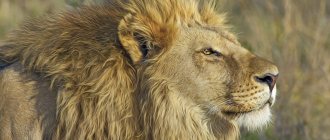The mongoose is a small but very brave animal. These little predators are known to every child from Kipling's cartoon "Riki-Tiki-Tavi", but not everyone knows that the cartoon characters actually existed. Real mongooses, like the cartoon character, protect their holes and the homes of their owners from a very real threat.
In Africa, people feed mongooses, and they, in turn, rid their homes of mice and destroy all snake nests within the radius of their habitat. An unusual pet is capable of becoming so attached to its owner that it can die from melancholy due to a long separation.
Description
South African mongooses are small animals with a long, slender body, as well as long, bushy tails and short legs. Weight from 490 to 1250 g, body length without tail 296-425 mm, and tail length 205-340 mm. The muzzle is elongated, the ears are small and rounded, 15-36 mm long. There are five toes on each paw. The claws are poorly developed. The coat is dark brown with gray streaks, the legs and paws are darker than the rest of the body. South African mongooses are characterized by sexual dimorphism. Males are 1.24 times larger and heavier than females.
There are three recognized subspecies of the South African mongoose: G. p. pulverulenta, G. p. basuticus, and G. p. ruddi, the first two subspecies are similar in appearance, but G. p. pulverulenta is slightly paler in color due to its fluffy undercoat. The third subspecies of G. p. ruddi has a yellowish coat with a dark undercoat, which makes its color brownish.
Population and species status
Since mongooses reproduce quite quickly, many countries have banned the import of these animals into their countries. After some time, mongooses begin to feed not only on game, but also switch to feeding on farm products in the form of poultry.
Interesting moment! In the century before last, thanks to human activity, mongooses appeared on the Hawaiian islands. The purpose of their settlement was to fight rodents that mercilessly ate sugar cane. As a result, mongooses began to pose a serious threat to local animals.
In turn, the mongooses themselves suffer from human activity, as he deprives them of their natural habitats, cutting down forests, and actively developing new territories. In addition, mongooses are hunted with dogs for their fluffy tails.
All these negative influence factors force the animals to go in search of new habitats. Due to unreasonable human actions, some species are on the verge of extinction, while another part of the species, on the contrary, has a negative impact on other animal species, pushing them to the same dangerous point as complete extinction.
Habitat
South African mongooses are found in a variety of habitats, ranging from open country and semi-desert to moist forests. Their habitat range extends from sea level to 1900 m above sea level in the KwaZulu-Natal province. South African mongooses are attracted to areas of dense bush, rocky outcrops and grass-covered boulders. They avoid areas with short vegetation. They can also be found near populated areas.
Key Features
Nimble mongooses are mainly diurnal and sleep at night, however, here everything again depends on the species.
The animal’s hole is invisible to surrounding eyes, since it always tries to disguise the entrance there. Animals usually hunt within their home (within a radius of up to 1 km). They have the following qualities important for a predator:
- sharp eyesight and a keen sense of smell, but as for hearing, the animal’s hearing is weak by nature, but this does not prevent it from hunting;
- fantastic speed, as well as resourcefulness (their reaction speed is one of the highest in the animal world);
- a special strategy for conducting a battle (no matter who is in front of him - the enemy or the victim - the mongoose discourages everyone with its sharp attacks);
- thick and dense fur, which can protect the animal’s body from snake bites (in particular, cobras);
- long and sharp claws and teeth capable of causing serious injury or damage to the enemy;
- the ability to emit a sharp unpleasant odor emanating from special glands at the anus, which often saves animals from danger.
Interesting! The natural agility, as well as the extraordinary maneuverability of these animals, led the Russian armed forces to the idea of creating a high-speed boat, called the Mongoose. It first appeared in 2000.
Reproduction
Currently, little information is known about the mating behavior of the South African mongoose. However, in other African mongoose species, males and females tend to come together only to mate. Males look for an opportunity to copulate with several females.
The breeding season occurs at the end of the rainy season (August to December). Various shelters such as rock cracks, tree hollows and abandoned burrows are used by female South African mongooses to raise their young. The maximum weight of a newborn mongoose is 20.2 g. Litters consist of 1 to 3 completely blind and deaf cubs. The young remain in the burrows until they are completely weaned from their mother's milk.
Natural enemies of mongooses
Photo: Mongoose animal
It is not easy for mongooses in the wild and harsh nature. Of course, they are predators, but their size is very miniature in order to feel completely safe. This is why solitary mongooses begin their hunt only at twilight, while collective individuals always have a guard. It is especially difficult for dwarf mongooses in this regard; it is good that they have such a useful ally as the hornbill, warning from above about the danger.
Natural enemies of mongooses include leopards, caracals, servals, jackals, and large poisonous snakes. The mongoose can be saved from them by its swiftness, agility, resourcefulness, and high speed when running. Hiding from pursuit, mongooses often use confusing and advantageous routes. Their small size allows mongooses to escape the sight of larger animals, which saves their lives.
Most often, inexperienced young animals or small cubs that do not have time to escape into the hole fall into the mouths of predators. But with predatory and large birds the situation is much worse; it is difficult for a mongoose to hide from them, because from above birds can see much more than a small animal. Bird attacks can also be lightning fast and unexpected, which is why many mongooses die under their sharp and powerful claws.
As for snakes, some species of mongoose fight desperately and successfully against them, because it’s not for nothing that they became the heroes of Kipling’s story. For example, the Indian mongoose is capable of killing a spectacled cobra that reaches a length of two meters. If the snake does bite the mongoose, then it may well avoid death by eating a healing root called "mangoosevil", which neutralizes the snake's poison, saving the mongoose from death.
It is worth noting that the mongoose does not always flee; sometimes it has to engage in battle with an ill-wisher, showing its courage and fighting spirit. Mongooses bristle, arch their backs, make growling and barking sounds, raise their long tail like a tube, bite hard and shoot foul-smelling secretions from their anal glands. These little daredevils have such a solid arsenal of protective properties in their piggy bank.
Nutrition
South African mongooses are primarily carnivores. Their diet mainly consists of small mammals, especially rodents. The rodents Myotomys unisulcatus and Rhabdomys Pumilio make up the majority (over 90%) of their diet in the West Coast National Park. Insects (especially beetles and termites) are a minor resource (less than 5% of the diet). Also, these mongooses prey on birds (mainly passerines), reptiles, amphibians, arachnids, decapods and mollusks. They can also consume carrion.
Links[edit]
- ^ abcd Chowdhury, A.; Timmins, R.; Chutipong, W.; Duckworth, J. W.; Mudappa, D.; Willcox, D. H. A. (2015). "Herpestes urva (revised version published 2016)". IUCN Red List of Threatened Species
.
2015
: e.T41618A86159618. Retrieved December 24, 2022. - Wozencraft, W. C. (2005). "Predator Squad". In Wilson, Delaware; Reader, D. M. (ed.). Mammal Species of the World: A Taxonomic and Geographical Guide (3rd ed.). Johns Hopkins University Press. pp. 569–570. ISBN 978-0-8018-8221-0. OCLC 62265494.
- ^ ab Hodgson, B. H. (1836). "A synoptic description of various new animals listed in the Catalog of Nepalese Mammals". Journal of the Asiatic Society of Bengal
.
5
: 231–238. - ^ abc Van Rompuy, H. (2001). "Crab mongoose, Herpestes urva". Small Carnivore Conservation
(25): 12–17. - ^ a b Thapa, S. (2013). "Observations of the crab-eating mongoose Herpestes urva in eastern Nepal". Conservation of Small Carnivores
.
49
: 31–33. - Chowdhury, A. (1997). "Distribution and status of small carnivores (mustelids, viverrids and herpestids) in Assam, India". Small Carnivore Conservation
(16): 25–26. - Chowdhury, A. (1997). "Small carnivores (mustelids, viverrids, herpestids and one ailurid) in Arunachal Pradesh, India." Small Carnivore Conservation
(17): 7–9. - Than Zaw; Saw Htun; Saw Htoo Tha Po; Myint Maung; Lynam, A. J.; Kyaw Tinn Latt; Duckworth, J. W. (2008). "Status and distribution of small carnivores in Myanmar". Small Carnivore Conservation
(38): 2–28. - Lau, M.W.N.; Fellowes, JR; Chan, B. P. L. (2010). "Carnivores (Mammalia: Carnivora) in Southern China: a status review with notes on commercial trade." Review of Mammals
.
40
(42): 247–292. DOI: 10.1111/j.1365-2907.2010.00163.x.
Behavior
The South African mongoose is diurnal, active from sunrise to sunset, with short periods of rest in the midday heat. They are generally solitary animals, although males exhibit sociality from time to time. Feeding behavior involves moving quickly between potential feeding sites and digging through the soil in search of prey below the surface. The South African mongoose is a terrestrial animal, but can also climb trees quite well. Fecal excrement occurs singly or in small groups, usually close to animal shelters. They do not use burrows outside of the breeding season.
The territorial range of the South African mongoose covers an area of 0.21 to 0.63 square kilometers. The ranges of females are smaller than those of males.
Wild Lifestyle
Some species lead a terrestrial lifestyle, while others lead a terrestrial-arboreal lifestyle. There is even a semi-aquatic species - the water mongoose.
Being predators, most species prefer to live alone. Only females with teenage cubs form stable groups. A typical example of social organization is the Egyptian mongoose. Each female occupies a certain territory, which she jealously protects from the invasion of strangers. Males also guard their territory, and their individual territories are larger than those of females. Sexually mature females and males are rare outside the breeding season. After mating, the partners disperse; males usually do not take any part in raising the younger generation.
But some species have nevertheless adapted to living in groups. For example, the dwarf mongoose. This species is very small, weighing no more than 350 grams, so it is very vulnerable to a large number of predators. He needs to constantly be aware of what is happening at the moment both on the ground and in the air. This is especially important when searching for food. A group lifestyle allows these animals to survive in a hostile world. Groups of dwarf mongooses consist of 2-20 adults (average 9), led by a breeding female.
The photo shows a friendly family of dwarf mongooses
Species such as the meerkat and banded mongoose are also social. They are also attacked by numerous predatory mammals and birds. When the family is feeding, one of the meerkats climbs to a high place and inspects the area for danger. Seeing a predator, the sentry emits a loud alarm, and the entire group rushes for cover.
The sound repertoire of mongooses is diverse and plays an important role in the life of these small predators. They growl, squeal, cackle, and their alarm calls resemble the barking of a dog.
The breeding season for different species occurs at different times. Pregnancy lasts about 60 days. Usually 2-4 cubs are born, sometimes their number reaches 6.
Enemies and friends of mongooses
Among the terrestrial predators, mongooses are annoyed by jackals, servals, caracals, and leopards. But birds of prey pose a particular danger to them. And if mongooses can cover short distances as quickly as larger land predators, then birds of prey approach at a speed that significantly exceeds the maximum speed of our heroes. In addition, a terrestrial predator, chasing prey, cannot constantly keep it in its field of vision; birds of prey have excellent visibility, which makes the animals’ attempts to choose a safe route useless. Therefore, death in the claws of a bird of prey is not uncommon for mongooses.
However, dwarf mongooses living in Kenya's Taru Desert have unusual allies. They are always accompanied by hornbills, monitoring the situation in the air.
In the morning, birds, sitting in the trees around the termite mounds, wait for the mongooses. As soon as the animals come out, the whole company goes hunting. In fact, the benefits of their cooperation are obvious. The birds catch grasshoppers and flying insects that are scared off by mongooses. On the other hand, hornbills are very good guards. Several birds monitor safety at once. Seeing an enemy, the birds fly up into the trees and fill the area with loud cries. Mongooses run as fast as they can to the nearest shelter. An interesting fact is that the feathered guards raise the alarm when birds of prey appear that are not dangerous to themselves, but attack the mongoose cubs. However, they do not react in any way to birds, which do not pose a threat to small predators. With such vigilant protection, the mongooses themselves do not even have to keep a watch. Fully trusting their feathered friends, the animals can devote more time to searching for food. And although they have to share their food with the hornbills, everyone benefits from such cooperation. This is an amazing case of mutually beneficial cooperation between mammals and birds.
Conservation in nature
Despite the fact that mongooses have many enemies in nature, they are a widespread and prosperous group of mammals. Most species are common, but due to the destruction of natural habitats, the Madagascar species are the most vulnerable.
Javan, yellow mongooses and meerkats have been exterminated by humans, but nevertheless remain numerous. Two South African species and a meerkat have been persecuted as carriers of rabies. The Java mongoose was first introduced to the West Indies in 1870 and to Hawaii in the 1880s to control rats in sugarcane fields, but subsequently became a pest because it kills native fauna.
Mongooses live quite a long time - in captivity up to 12-13 years. However, under natural conditions their age is shorter - about 6-7 years.
- Slithertooth
- European…
- Common spadefoot
- Bandicoot…
- Kinkajou: photo, description
- Serval: how does he live...
Raising offspring
As soon as the cubs emerge from the burrow, they almost immediately begin to eat solid food. At the age of 2 weeks, babies acquire sight and hearing, so all they have to do is learn to hunt.
Adult members of the group sometimes bring food to the cubs, and female mongooses feed milk not only to their own, but also to other people’s “children.”
Interesting! These animals raise their babies all together. Upon reaching 3-4 months, the young animal acquires a patron who takes care of it for a certain time and teaches it the necessary skills. This way, the younger generation in the group is provided with reliable care.
At 5 months, the young animal no longer needs mother's milk. Then feeding stops. The female mongoose reaches sexual maturity at 9 months, and the male only at one year. Few animals survive to the age when they can have offspring, since they have many enemies.
Grown mongooses usually leave their group for neighboring ones, where they then produce offspring.
Thus, these small predators are not threatened with degeneration due to inbreeding. Wildlife lovers often manage to take photos of animals from an interesting angle.
Relationships with people
Baby mongooses get used to people faster than adults. The latter will need some time to establish contact with the person.
At first, the animal may even use its teeth and claws. Do not forget that this is a predator, albeit a small one, and you need to behave carefully with it.
Another inconvenience that a mongoose can cause to its owner is a specific smell, just like a ferret , which the animal emits thanks to its scent glands. He also likes to mark his territory.
You need to get used to this and not scold your pet without a significant reason.
Sometimes the animal can be released from the cage to frolic a little. This way the owner will see what the mongoose looks like in the game.
However, under no circumstances should he be left unattended: he is capable of chewing furniture, digging up the lawn, breaking something, and even running away.
Interesting! Scientists conducted a study that proved that mongooses produce sounds similar to human speech at the stage of its formation.
In general, the animal gives a lot of positive emotions, responding to calls and climbing into your arms, which makes it an excellent pet.
Video
Content
In India, the animal has long been domesticated. Some entrepreneurs in this country create special nurseries where mongooses are bred.
Their grown cubs are sold there. If you want to take a small predator into your home, you need to know some points about its content.
- A mongoose needs a spacious cage. The animal cannot sit for a long time in a cramped and confined space. He gets bored there.
- Inside the cage you need to create the appropriate environment: place a couple of driftwood, put a ball or some other toy, put a tray for the mongoose’s needs.
- The animal is unpretentious in food. He can be given meat, fish, raw eggs, cottage cheese, vegetables and fruits. It is better to make the diet varied, combining animal and plant foods.
- To observe what a mongoose looks like during a hunt, sometimes you can bring a mouse, cockroach or frog into its cage. In this case, you should not experiment with snakes.
Interesting! Mongooses became famous among people after the release of R. Kipling’s story “Rikki-Tikki-Tavi”, where the main character, a mongoose, subsequently saved a child and his entire family from cobras.
You should not keep a mongoose with pets such as degu and lemmings - he will perceive them as a delicacy for lunch.
